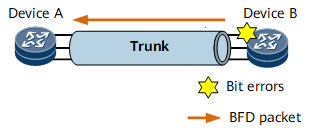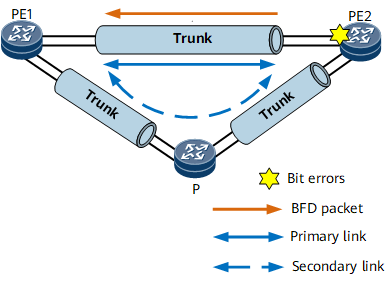Bit-Error-Triggered Trunk Update
Background
If a trunk interface is used to increase bandwidth, improve reliability, and implement load balancing, deploy bit-error-triggered trunk update to cope with bit errors detected on trunk member interfaces.
Implementation Principles
According to the types of protection switching triggered, bit-error-triggered trunk update is classified as follows:
Trunk-bit-error-triggered section switching
On the network shown in Figure 1, trigger-section or trigger-LSP bit error detection must be enabled on each trunk member interface. After detecting bit errors on a trunk interface's member interface, a device advertises the bit errors to the trunk interface, triggering the trunk interface to delete the member interface from the forwarding plane. The trunk interface then does not select the member interface to forward traffic. After the bit errors are cleared from the member interface, the trunk interface re-adds the member interface to the forwarding plane. The trunk interface can then select the member interface to forward traffic. If bit errors occur on all trunk member interfaces or the number of member interfaces without bit errors is lower than the lower threshold for the trunk interface's Up links, the trunk interface goes Down. An upper-layer application associated with the trunk interface is then triggered to perform a service switchover. If the number of member interfaces without bit errors reaches the lower threshold for the trunk interface's Up links, the trunk interface goes Up. An upper-layer application associated with the trunk interface is then triggered to perform a service switchback.
The device also notifies the BFD module of the bit error status, and then uses BFD packets to advertise the bit error status to the peer device connected to the trunk interface.
If trunk-bit-error-triggered section switching also has been deployed on the peer device, the bit error status is advertised to the trunk interface of the peer device. The trunk interface is then triggered to delete or re-add the member interface from or to the forwarding plane. The trunk interface is also triggered to go Down or Up, implementing switchover or switchback synchronization with the device.
- If trunk-bit-error-triggered section switching is not deployed on the peer device, the peer device cannot detect the bit error status of the interface's link. To ensure normal running of services, the device can receive traffic from the member interface with bit errors in the following cases:
- The trunk interface of the device has deleted the member interface with bit errors from the forwarding plane or has gone Down.
- The trunk interface of the peer device can still forward traffic.
Trunk-bit-error-triggered section switching is similar to common-interface-bit-error-triggered section switching. If bit errors occur on the trunk interfaces on both the primary and secondary links, trunk-bit-error-triggered section switching may interrupt services. Therefore, trunk-bit-error-triggered IGP route switching is recommended.
Trunk-bit-error-triggered IGP route switching
On the network shown in Figure 2, link-quality bit error detection must be enabled on each trunk member interface, and bit-error-triggered IGP route switching must also be deployed on the trunk interface. After detecting bit errors on a trunk interface's member interface, a device advertises the bit errors to the trunk interface, triggering the trunk interface to delete the member interface from the forwarding plane. The trunk interface then does not select the member interface to forward traffic. After the bit errors are cleared from the member interface, the trunk interface re-adds the member interface to the forwarding plane. The trunk interface can then select the member interface to forward traffic. If bit errors occur on all trunk member interfaces or the number of member interfaces without bit errors is lower than the lower threshold for the trunk interface's Up links, the trunk interface ignores the bit errors on the member interfaces and remains Up. However, the link quality level of the trunk interface becomes Low, triggering an IGP (OSPF or IS-IS) to increase the cost of the trunk interface's link. IGP routes then do not preferentially select the link. If the number of member interfaces without bit errors reaches the lower threshold for the trunk interface's Up links, the link quality level of the trunk interface changes to Good, triggering the IGP to restore the original cost for the trunk interface's link. In this case, IGP routes preferentially select the link again.
The device also notifies the BFD module of the bit error status, and then uses BFD packets to advertise the bit error status to the peer device connected to the trunk interface.
If trunk-bit-error-triggered IGP route switching also has been deployed on the peer device, the bit error status is advertised to the trunk interface of the peer device. The trunk interface is then triggered to delete or re-add the member interface from or to the forwarding plane. The link quality level of the trunk interface is also triggered to change to Low or Good. In this case, the cost of IGP routes is adjusted, implementing switchover or switchback synchronization with the device.
If trunk-bit-error-triggered IGP route switching is not deployed on the peer device, the peer device cannot detect the bit error status of the interface's link. If the trunk interface of the device has deleted the member interface with bit errors from the forwarding plane, the trunk interface of the peer device may still select the member interface to forward traffic. Similarly, if the link quality level of the trunk interface on the device has changed to Low, the IGP is triggered to increase the cost of the trunk interface's link. In this case, IGP routes do not preferentially select the link. However, IGP on the peer device does not adjust the cost of the link. Traffic from the peer device may still pass through the link with bit errors. As a result, bidirectional IGP routes pass through different links. To ensure normal running of services, the device can receive traffic from the member interface with bit errors. However, bit errors may affect service quality.

Layer 2 trunk interfaces do not support an IGP. Therefore, bit-error-triggered IGP route switching cannot be deployed on Layer 2 trunk interfaces. If bit errors occur on all Layer 2 trunk member interfaces or the number of member interfaces without bit errors is lower than the lower threshold for the trunk interface's Up links, the trunk interface remains in the Up state. As a result, protection switching cannot be triggered. To eliminate the impact of bit errors on services, you must manually restore the link quality.
Usage Scenario
If a trunk interface is deployed, deploy bit-error-triggered trunk update to cope with bit errors detected on trunk member interfaces. Trunk-bit-error-triggered IGP route switching is recommended.

